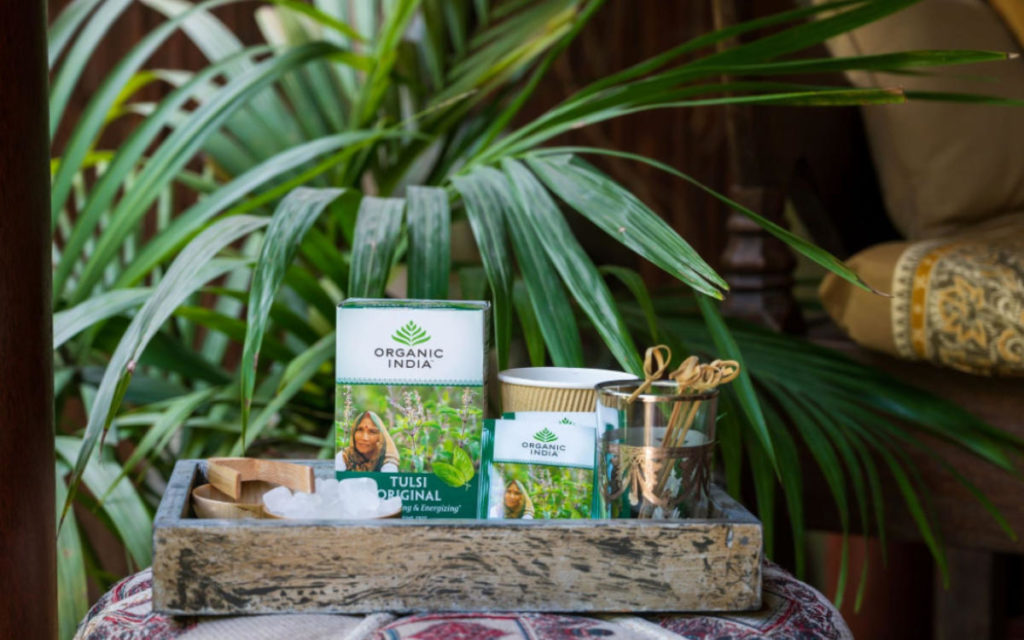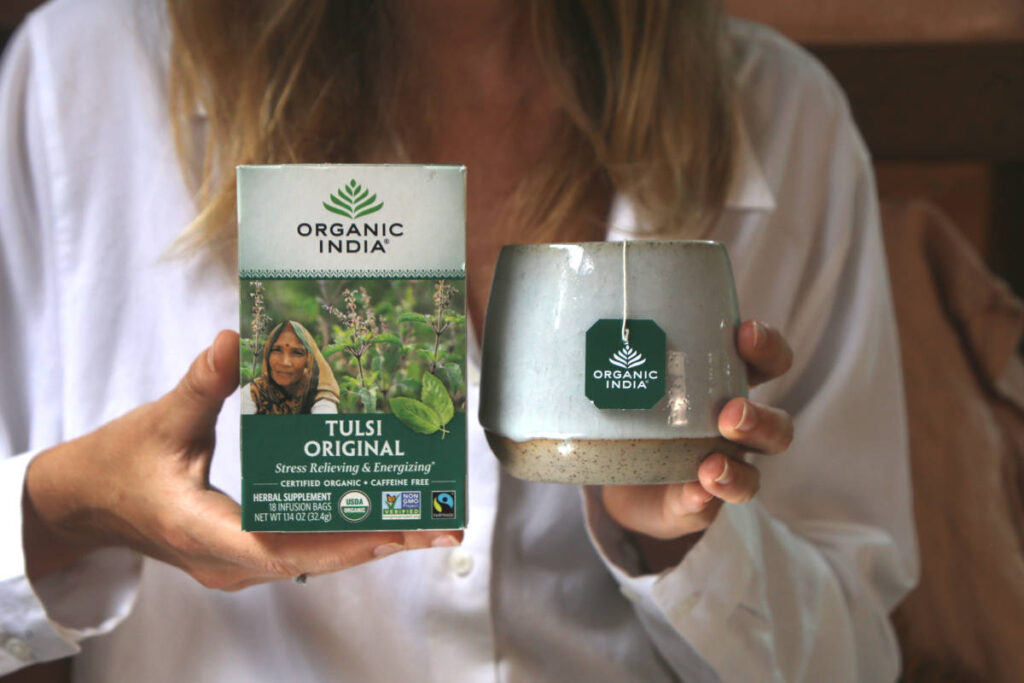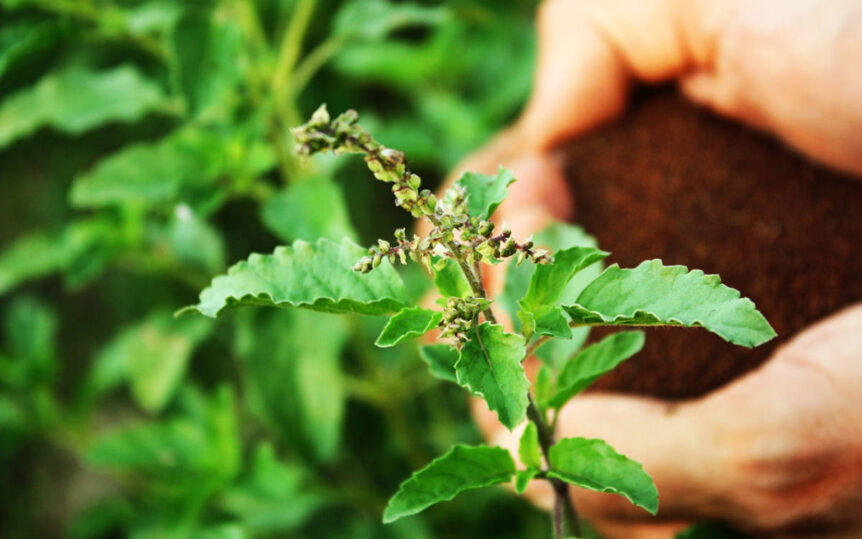Back
Tulsi and Basil are two herbs with a rich heritage in cultural traditions and the culinary arts. While they belong to the same botanical family, which provides some similarities, they also have distinct differences. In this article, we’ll compare Tulsi vs Basil and explore the details that set these verdant aromatic herbs apart.
Is Tulsi the Same As Basil?
Although Tulsi and Basil belong to the Lamiaceae family, they are very distinct in their flavor, aroma, and cultural significance. Lamiaceae is the mint family of flowering plants, which includes Tulsi and Basil, among its more than 7,000 species.
Tulsi, also known as “Queen of Herbs,” is a culinary staple in Indian cuisine. It is a revered herb with green or purplish leaves, often grown in Indian households for its protective properties. Tulsi is mainly used in tea infusions but has been used in wellness applications for centuries due to its antimicrobial properties.
Basil is a flavorful herb with glossy green, oval-shaped leaves. It is most often used in Italian cuisine but also in Thai, Vietnamese, and Cambodian fare. It has a sweet fragrance and a slightly peppery taste.
What Is Tulsi Called in the USA?
In the United States, Tulsi is called “Holy Basil.” As the name suggests, Holy Basil embodies spiritual purity and is recognized as a sacred plant in Hinduism. Tulsi has been a staple of Ayurvedic wellness practices for thousands of years. In modern times, it has emerged as a potent adaptogen that helps to relieve stress, support immune function, and bring a sense of calm to those who use it.
Tulis can be found in natural food stores, Indian grocery stores, temples, or online. At ORGANIC INDIA, we partner with organic wildcrafters to source Tulsi for our herbal tea infusions and immune-supporting supplements.

Is Tulsi the Same As Holy Basil?
Yes, Tulsi and Holy Basil refer to the same herb. “Tulsi” is used in the Indian subcontinent, while “Holy Basil” is more commonly used in the West. Both names refer to the Ocimum sanctum plant, which is part of the mint family.
In Hinduism, Tulsi is a sacred plant regarded as the manifestation of the goddess Lakshmi. She is the goddess of fortune, prosperity, power, and fertility. Ayurvedic practitioners rely on Tulsi extensively for its unparalleled health-promoting properties to aid in mild to severe conditions.
Tulsi vs. Basil: The Key Differences
Even though Tulsi and Basil are from the same family, they vary in flavor profile, appearance, origin, uses, and benefits. The following sections will help you quickly compare Tulsi vs Basil.
Scientific Name
As mentioned, both herbs belong to the Lamiaceae family, which consists of mint plants and culinary herbs like rosemary, sage, marjoram, oregano, hyssop, lavender, and thyme. The family also includes medicinal herbs such as wild dagga, salvia, bee balm, and catnip.
Tulsi: Ocimum tenuiflorum — sometimes referred to by its synonym, Ocimum sanctum.
Basil: Ocimum Basilicum
Flavor
Both herbs have distinct flavor profiles, so it’s not recommended to substitute one for the other in recipes.
Tulsi: What does Tulsi taste like?
Tulsi has an aromatic minty flavor with a hint of pepper. It can be pungent and sometimes bitter, but it can also have floral notes and the flavors of clove and lemon.
Basil: What does Basil taste like?
Basil is sweet, spicy, and slightly peppery. It strikes a delicate balance between sweet and savory, encompassing hints of mint and anise.

Appearance
There are more than 7,000 species in the Lamiaceae family, many of which are cultivated for their fragrant leaves and delightful flowers. While there are similarities, distinguishing between Tulsi vs Basil comes down to a few easily identifiable but distinct characteristics.
Tulsi: Tulsi is a small annual shrub that grows up to three feet tall. Its fragrant leaves are oval-shaped with slightly pointed tips and faintly toothed edges. Depending on the variety, the leaves can be green or purple and grow opposite each other along a hairy stem. The Tulsi plant produces a small purple or white tubular flower.
Basil: Basil leaves are broad and oval-shaped and glossy, vibrant green. The smooth or slightly toothed edges cup somewhat, giving them their distinctive look. The stems grow tall and bushy, with leaves arranged on opposite sides of the square stems. Depending on the variety, Basil flowers come in various colors, from white to purple to magenta. Basil grows best in warm, tropical climates with plenty of sun and water.

Origins
Like most ancient herbs, Tulsi and Basil have a history dating back thousands of years. From their origin countries, the benefits of their uses have been passed down through the generations and spread across the globe.
Tulsi: Originating in north-central India, Tulsi has been cultivated for thousands of years for medicinal, culinary, and sacred uses. It now grows natively throughout the Indian subcontinent, China, and Southeast Asia.
Basil: While we generally associate Basil with Italian food, it is actually native to the tropical regions of Central Africa and Southeast Asia, including the Indian subcontinent. The earliest reference to this verdant herb dates back to Indian Vedic texts over 5000 years ago.
Uses
Tulsi and Basil have been used for many purposes throughout history—culinary, therapeutic, and spiritual. Each part of the plant, from the roots to the leaves and flowers, has something to offer.
Tulsi: In Hinduism, every part of the Tulsi plant is revered, including the flower, leaves, stem, root, and seeds. The word “tulsi” means “the incomparable one.” Hindus believe the plant can bring good luck, wealth, and prosperity.
In addition to its religious significance, Tulsi is a staple in Ayurvedic remedies for its adaptogenic properties, which have been used for thousands of years to promote calm and inner peace. The plant is rich in antioxidants, which bolsters healthy immune function. Due to its antimicrobial properties and bioactive components, it can be used for sanitizing and purifying.
Basil: Basil is one of the most widely used herbs globally. It is primarily used in cooking and is often added to fresh and cooked recipes for flavor enhancement. Fresh Basil leaves are often added to the recipe’s final step so that the herb’s distinctive flavor can be appreciated. The flavor compounds in Basil are heat-sensitive, and cooking can quickly spoil the herb’s flavor profile.
In ancient Egypt, Basil was used in mummification and has even been found inside tombs. The ancient Romans considered it a magical and sacred plant, while the Greeks assigned it a negative value. Given Basil’s sweetly intense aroma, it’s no surprise that it has been used in perfumery and incense throughout history.

Benefits
Before modern medicine, Ayurvedic practitioners understood herbs and spices’ powerful blessings and benefits for spiritual wellness and physical healing. Working with different herbs, they refined their knowledge and crafted teas, infusions, and tinctures to support health and aid the body in its natural healing processes.
Tulsi Benefits: Tulsi is an adaptogenic herb with many benefits for overall health and harmony. Its robust antioxidant and antimicrobial properties make it a fundamental herb for supporting immune function and respiratory health, and its adaptogenic properties promote calmness, uplift moods, and relieve stress.
Basil Benefits: Did you know there are over sixty varieties of Basil? Sweet Basil is probably the most widely used, but you can also find cinnamon Basil, lemon Basil, Thai sweet Basil, and dark opal Basil. Each variety has its own distinctive qualities, but Basil generally provides myriad health benefits.
Basil contains numerous vitamins, minerals, antioxidants, and essential oils. The antioxidants help fight against free radicals that can lead to cell damage in the body. The essential oils support a healthy inflammatory response, and the antibacterial properties help support a healthy immune response.

Tulsi vs Basil: Two Incredible Herbs
Even though Tulsi and Basil share the same botanical family and look similar, they have many differences in flavor, use, and cultural significance. Tulsi, also known as Holy Basil, is revered in Ayurvedic practice and Hindu culture. It is celebrated for its health-promoting qualities and spiritual attributes. On the other hand, Basil is a common kitchen herb cherished for its culinary versatility and fresh aroma.
Understanding the difference between Tulsi vs Basil helps inform which one to choose regarding cooking and wellness practices. Whether steeping a soothing cup of Tulsi tea or garnishing your favorite Italian dish with fresh Basil leaves, you pay homage to centuries-old traditions with rich cultural significance. By embracing the unique qualities of Tulsi and Basil, you just might find yourself welcoming luck, prosperity, and good health into your life.
Find more ways to enrich your life with the many renditions of Tulsi tea available at ORGANIC INDIA. With Tulsi as the staple ingredient, we’ve crafted infusions for sleep, stress relief, digestive support, and more.


















 Kate Tant is a professional health and wellness writer with a strong passion for holistic wellness. Her writing covers topics from Ayurvedic herbs and practices to nontoxic living and intermittent fasting. Her conversational writing style resonates with readers who are looking for help and encouragement when it comes to finding natural solutions to their health.
Kate Tant is a professional health and wellness writer with a strong passion for holistic wellness. Her writing covers topics from Ayurvedic herbs and practices to nontoxic living and intermittent fasting. Her conversational writing style resonates with readers who are looking for help and encouragement when it comes to finding natural solutions to their health.